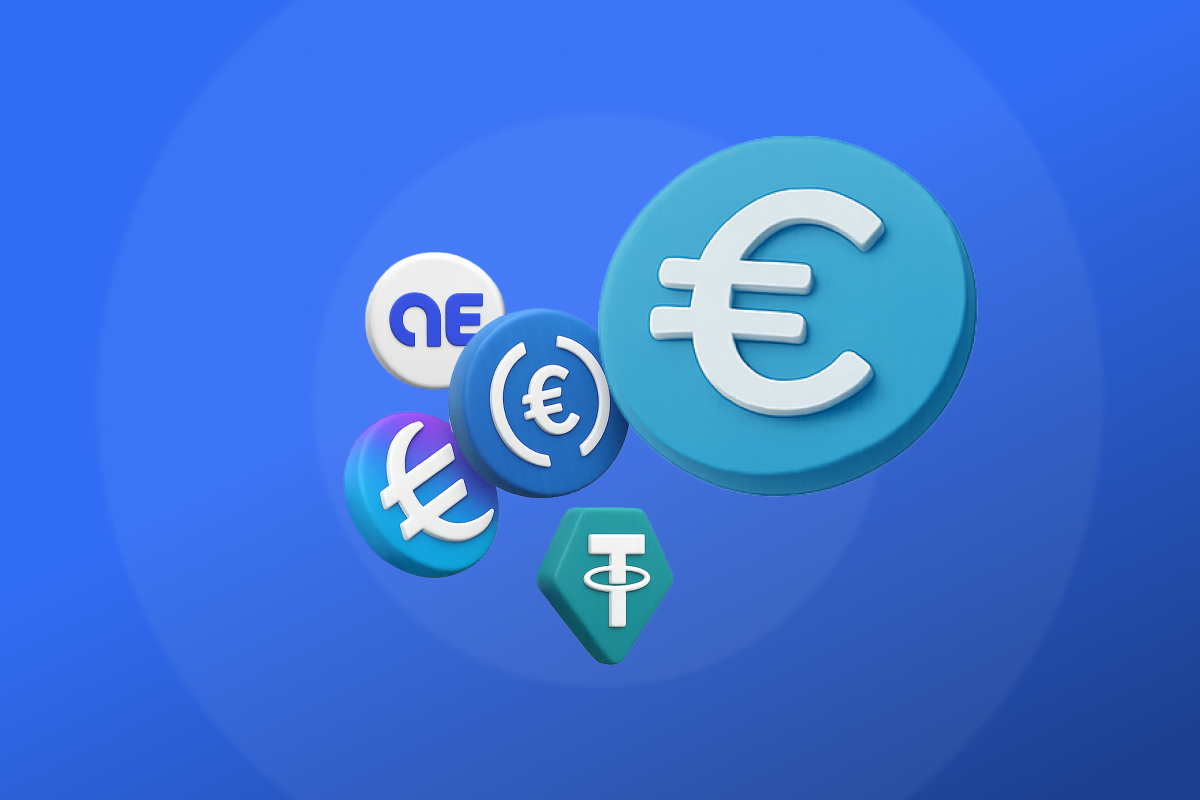
Best Euro Stablecoin Providers in 2025
In this article, we’ll compare the leading euro stablecoin issuers in 2025 by compliance, fees, and on/off-ramp access.
Why Euro stablecoins matter
Euro stablecoins are more than a regional alternative to USD tokens. They reflect Europe’s push for monetary and technological sovereignty, helping to hedge against the weakening dollar and global geopolitical risks. With MiCA regulation and a strong legal base, they make the euro fit for the digital age. SEPA is efficient, but euro stablecoins enable programmable settlements and global payments.
How to Choose the Right Provider
Selecting a euro stablecoin provider isn’t just about cost or convenience, it’s also a compliance decision. Under MiCA, issuing and using fiat-backed tokens is a regulated financial activity. Choosing the wrong partner could expose your platform to payment service interruptions or even legal liability. The right provider gives you both a compliant foundation and a seamless technical stack.
What to prioritize:
- Compliance: Work only with EMI-licensed issuers authorized under MiCA. This ensures that every transaction is backed by safeguarded funds, redeemable at par, and recognized across the EEA.
- On/Off-Ramp: The on/off-ramp is critical for your user experience. To reach mainstream users, it needs to bridge banks and blockchains so users can move euros instantly, without friction or extra steps.
- API: A good API should let you onboard users, trigger payouts, and provide payment notifications and automation through webhooks.
- Cost: Look for transparent and fair pricing to ensure predictable performance at scale.
- Reliability: Look for volume at scale and real partnerships.
With these criteria in mind, let’s examine each leader.
1. Monerium EURe
Summary: The only fully regulated euro stablecoin with direct user access, own-name IBANs, and real on/off-ramp automation.
Overall: 5/5 – The gold standard for compliance and accessibility.
- Compliance (5/5): Licensed as a MiCA-compliant Electronic Money Institution (EMI) authorized to issue fiat-backed stablecoins in EEA, UK, and Switzerland.
- On/Off-Ramp (5/5): Provides personal IBANs that enable wallets to behave like regular bank accounts, allowing both own and third-party payments. All incoming euro payments are automatically minted as EURe tokens to the wallet. When you send EURe to a bank account, the tokens are burned and the recipient receives euros instantly.
- API (5/5): Developer-first design with webhook notifications and automated euro payouts and redemptions.
- Cost (5/5): No payment fees.
- Reliability (5/5): Over €6 billion in volume processed in 2025 and trusted by MetaMask and Gnosis Pay.
2. Circle EURC
Summary: MiCA-compliant and backed by a strong global brand, but access is limited to corporates and exchange partners.
Overall: 4/5 – Reliable and compliant, but not open to most users.
- Compliance (5/5): MiCA-compliant EMI licensed in France. Reserves held in EU banks and independently audited.
- On/Off-Ramp (3/5): Available only through corporate accounts or centralized exchanges — no direct user access.
- API (4/5): Mature API stack but focused on institutional integrations.
- Cost (4/5): Exchange spreads apply; no native retail pricing.
- Reliability (5/5): High global adoption and liquidity across major exchanges.
3. Anchored EUR (AEUR)
Summary: Early-stage Swiss-regulated issuer focusing on DeFi use cases; promising but limited footprint.
Overall: 3/5 – Transparent approach but lacks liquidity and tooling.
- Compliance (3/5): Swiss VASP registration; not MiCA-authorized in the EEA.
- On/Off-Ramp (2/5): Bank transfers via partner institutions; slower settlement times.
- API (3/5): Functional but not production-grade for fintech integrations.
- Cost (4/5): Transparent but variable fees.
- Reliability (3/5): Modest transaction volume; still building ecosystem traction.
4. Stasis EURS
Summary: One of the earliest euro stablecoins but now outdated — unregulated and largely exchange-dependent.
Overall: 2/5 – Legacy liquidity, limited compliance.
- Compliance (2/5): Not MiCA-compliant; relies on self-reported attestations.
- On/Off-Ramp (2/5): Exchange-only access; no banking connectivity.
- API (2/5): Limited developer tools and integrations.
- Cost (3/5): Exchange-based spreads; unpredictable pricing.
- Reliability (3/5): Still active but shrinking usage and institutional relevance.
5. Tether EURT
Summary: High liquidity but entirely unregulated; not suitable for compliant platforms or EU-based operations.
Overall: 1/5 – Liquidity without legal footing.
- Compliance (1/5): Offshore structure; no MiCA or EMI license.
- On/Off-Ramp (1/5): Available only through exchanges; no fiat bridge.
- API (1/5): None — not designed for developer integration.
- Cost (3/5): Exchange fees apply; limited transparency.
- Reliability (3/5): Large trading volume, but zero regulatory safeguards.
Conclusion
| EURe | EURC | AEUR | EURS | EURT | |
|---|---|---|---|---|---|
| Compliance | 🟢 | 🟢 | 🟡 | 🔴 | 🔴 |
| Ramp | 🟢 | 🟡 | 🔴 | 🔴 | 🔴 |
| API | 🟢 | 🟢 | 🟡 | 🔴 | 🔴 |
| Cost | 🟢 | 🟡 | 🟡 | 🟡 | 🟡 |
| Reliability | 🟢 | 🟢 | 🟡 | 🟡 | 🟡 |
If your platform needs instant euros that move between banks and blockchains compliantly, Monerium EURe is the clear choice. Circle EURC offers institutional credibility, but Monerium delivers what users and builders actually need: regulated access, automation, and scale.
How to integrate Monerium EURe
- Follow the Getting started guide to test the API for free.
- Read the EURe token docs for smart contract integration.
- For technical support join the Monerium Discord channel
- Get in touch with the team to know more or go live.